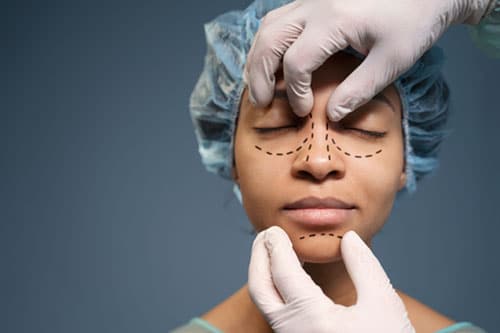Hollywood stars and spectacular makeovers are frequently associated with plastic surgery like gynecomastia surgery. The field of plastic surgery is much broader than just acquiring a desired appearance, but this is still a major component. In 2022, plastic surgeons worldwide performed more procedures than ever before, with a total of over 14.9 million surgeries and 18.8 million non-surgical procedures. This marks an 11.2% increase in overall procedures compared to the previous year. Over the past four years, there has been a significant 41.3% rise in aesthetic surgeries, showing a growing trend in people seeking these treatments.
Plastic surgeons are highly trained medical specialists who are essential in rebuilding and regaining function following diseases, birth deformities, and accidents. This article highlights the wide range of functions played by plastic surgeons and the astonishing scope of this medical speciality.
Table of Contents
The Encompassing Reach of Plastic Surgery In The Aesthetic World
Plastic surgery deals with the repair, reconstruction, or replacement of physical defects. This encompasses a wide range of areas, including the skin, musculoskeletal system, craniofacial structures, hands, extremities, breasts, trunk, and even external genitalia. Statistics reveal the substantial impact of plastic surgery, with over 14.9 million surgical and 18.8 million non-surgical procedures performed worldwide in 2022 alone. The field of aesthetic surgery, focused on improving appearance, has witnessed a significant rise of 41.3% in the last four years, highlighting its growing popularity.

Plastic surgeons are not solely focused on cosmetic enhancements. A significant portion of their expertise lies in reconstructive surgery, which addresses conditions arising from:
- Burns: Burn victims often face significant physical and emotional challenges. Plastic surgeons play a crucial role in burn treatment, minimizing scarring, restoring functionality, and promoting healing.
- Birth defects: Congenital malformations like cleft palates, craniosynostosis (fused skull sutures), or missing limbs can significantly impact a child’s development and quality of life. Plastic surgeons play a vital role in corrective procedures, restoring both form and function.
- Injuries: Accidents, both traumatic and non-traumatic, can leave behind significant scarring, tissue damage, or even loss of limbs. Plastic surgeons can reconstruct damaged tissues, minimize scarring, and improve functionality, allowing patients to regain mobility and confidence.
- Illnesses: Diseases like cancer can necessitate surgery that alters a patient’s appearance. Plastic surgeons can perform reconstructive procedures, such as breast reconstruction after mastectomy, to help patients regain a sense of normalcy.
These procedures go far beyond aesthetics. They aim to restore not just appearance, but also the ability to perform everyday tasks, alleviate pain, and boost a patient’s self-esteem.
A Deeper Look & Subspecialties Within Plastic Surgery
The vast scope of plastic surgery is further highlighted by the existence of subspecialties. These specialized areas allow plastic surgeons to refine their expertise and provide even more targeted care:
- Microsurgery: This intricate technique involves the use of specialized instruments and magnification to operate on tiny structures like nerves and blood vessels. Microsurgery plays a vital role in reconstructing severed limbs, transplanting tissues, and treating complex wounds.
- Craniofacial surgery: This subspecialty focuses on the reconstruction of the skull, face, jaws, ears, nose, and mouth. Craniofacial surgeons address birth defects, and facial trauma, and even perform procedures to correct sleep apnea.
- Hand surgery: Hands are complex structures essential for daily activities. Hand surgeons specialize in treating hand injuries, congenital malformations, and conditions like arthritis or carpal tunnel syndrome.
- Breast surgery: This subspecialty encompasses both reconstructive and aesthetic breast procedures. Breast surgeons perform breast reconstruction after cancer treatment, breast augmentation or reduction, and address issues like gynecomastia (enlarged male breasts).
- Aesthetic surgery: This is the most commonly recognized area of plastic surgery. Aesthetic surgeons perform procedures to improve a person’s appearance, such as liposuction, rhinoplasty (nose job), or eyelid surgery. However, it’s crucial to remember that even within aesthetics, function sometimes plays a role. For example, a rhinoplasty can address breathing difficulties alongside improving appearance.
When the goal is to enhance your appearance, it’s crucial to seek a qualified cosmetic surgeon. Remember, any licensed physician can perform cosmetic procedures; however, ensuring they possess the proper training and board certification by the American Board of Plastic Surgery (ABPS) is paramount. Board certification signifies expertise and adherence to the highest standards of patient care.
The Path to Becoming a Plastic Surgeon Is A Journey of Dedication

Plastic surgery is one of the most demanding and competitive specialities in medicine. The training path is rigorous, spanning over a decade. Following medical or osteopathic school, aspiring plastic surgeons embark on a residency program. There are two options:
- Combined six-year program: This simplified program provides a unified learning experience by combining general surgery and plastic surgery training. The first few years lay a solid basis for basic surgical ideas. Residents learn skills in wound care, anaesthetic management, and surgical methods that are useful to a variety of surgical specialities. This initial step provides them with the fundamental abilities required to handle a variety of surgical circumstances. The seminar then continues to a more in-depth look at plastic surgery fundamentals. Residents learn methods specific to this specialization, such as microsurgery, tissue transfer, and aesthetic surgery. This enables a progressive transition from general surgical concepts to the specific field of plastic surgery.
- Five-year general surgery residency followed by a dedicated three-year plastic surgery residency: This two-part program provides a unique educational experience. The first five years are spent rigorously training in general surgery. Residents become experts in a wide range of surgical procedures, including trauma surgery, gastrointestinal surgery, and surgical oncology. This extensive training promotes a high level of surgical competency and critical thinking. After completing their general surgery residency, aspiring plastic surgeons enrol in a three-year program that focuses on plastic surgery. This phase focuses on the precise procedures and principles unique to reconstructive and cosmetic surgery. Residents improve their skills in microsurgery, craniofacial surgery, and aesthetic operations.
To become a successful plastic surgeon, one can pursue either the combined six-year curriculum or the five-year general surgery residency followed by a three-year fellowship focused on plastic surgery. The best option is determined by the individual’s learning preferences and professional objectives. Aspiring cosmetic surgeons should carefully weigh the advantages and disadvantages of each path to ensure they choose the curriculum that best suits their goals and learning styles. Ultimately, both paths lead to a gratifying career committed to restoring shape and function, thereby improving the lives of patients.
The Daily Life of a Plastic Surgeon – Consultation, Collaboration, and Care
A plastic surgeon’s day has a carefully planned balance of accuracy, caring, and patient engagement. Each morning, these dedicated professionals rise early, often before daybreak, to mentally and physically prepare for the day ahead. Their practice often begins with consultations, in which they visit with patients to learn about their aesthetic or reconstructive needs, discuss various operations, and establish realistic expectations. This first engagement is critical for establishing trust and rapport and making patients feel informed and at ease.
In the operating room, plastic surgeons demonstrate their artistry and technical expertise. Each surgery, whether executing sophisticated microsurgeries or major reconstructive jobs involving tissue transfers, is carried out with painstaking attention to detail. Their stage is the operating theatre, where they collaborate with a team of professional anesthesiologists, nurses, and technicians to assure the safety and satisfaction of each patient. This teamwork is vital for the smooth progression of surgery and the patient’s well-being.
Post-operative care is equally important. After surgery, plastic surgeons meticulously monitor their patients’ recovery to manage any issues and ensure maximum healing. They give post-operative instructions, offer physical therapy if necessary, and organize follow-up appointments to evaluate the results of the treatments. Plastic surgeons balance their professional responsibilities with personal care throughout the day, ensuring that they are in good health to deliver the best possible care to their patients. Thus, a plastic surgeon’s everyday existence is more than just executing surgeries; it is firmly entrenched in empathy, patient safety, and the quest for medical perfection.
Considering The Growing Attitude Towards Plastic Surgery
Public perception often associates plastic surgery solely with aesthetics. However, the data paints a different picture. Studies reveal a significant gap between public understanding and the true scope of this field. Many individuals mistakenly believe plastic surgeons are primarily involved in elective cosmetic procedures.
This highlights the need for continued education and awareness campaigns to bridge this gap. By showcasing the breadth of plastic surgery and its transformative impact on patient’s lives, the public can gain a more comprehensive understanding of this remarkable medical speciality.
What’s Next? The Future of Plastic Surgery and Continued Growth
Plastic surgery is a dynamic field propelled by technological advancements and a dedication to enhancing patient care. Among the forefront of developments are minimally invasive techniques, which strive to reduce scarring and hasten recovery times, facilitating discreet procedures and quicker resumption of daily activities. Additionally, bioengineering breakthroughs offer hope for the creation of tissues tailored for reconstruction, particularly benefiting burn victims and individuals with extensive tissue damage.
Furthermore, 3D printing holds transformative potential by enabling the fabrication of personalized implants and prosthetics, enhancing both function and aesthetics for patients. These innovations underscore the evolving landscape of plastic surgery, promising improved outcomes and a broader scope of treatment options. As these technologies continue to progress, the positive impact of plastic surgery on patients’ lives is poised to expand even further.

